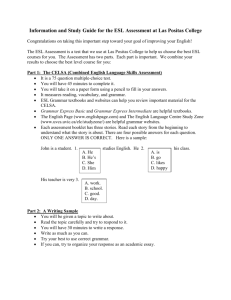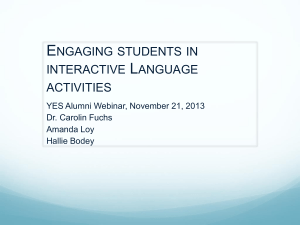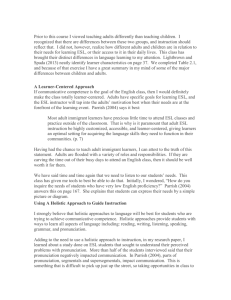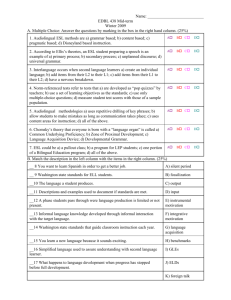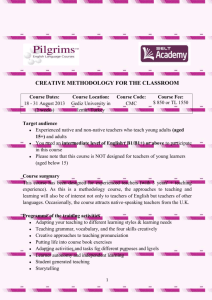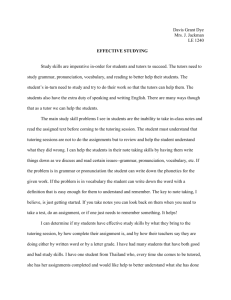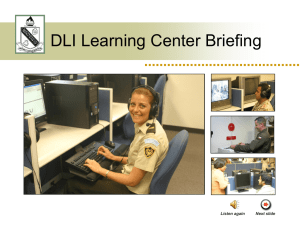Resoures 10 each - Aisi`s Teacher Portfolio
advertisement
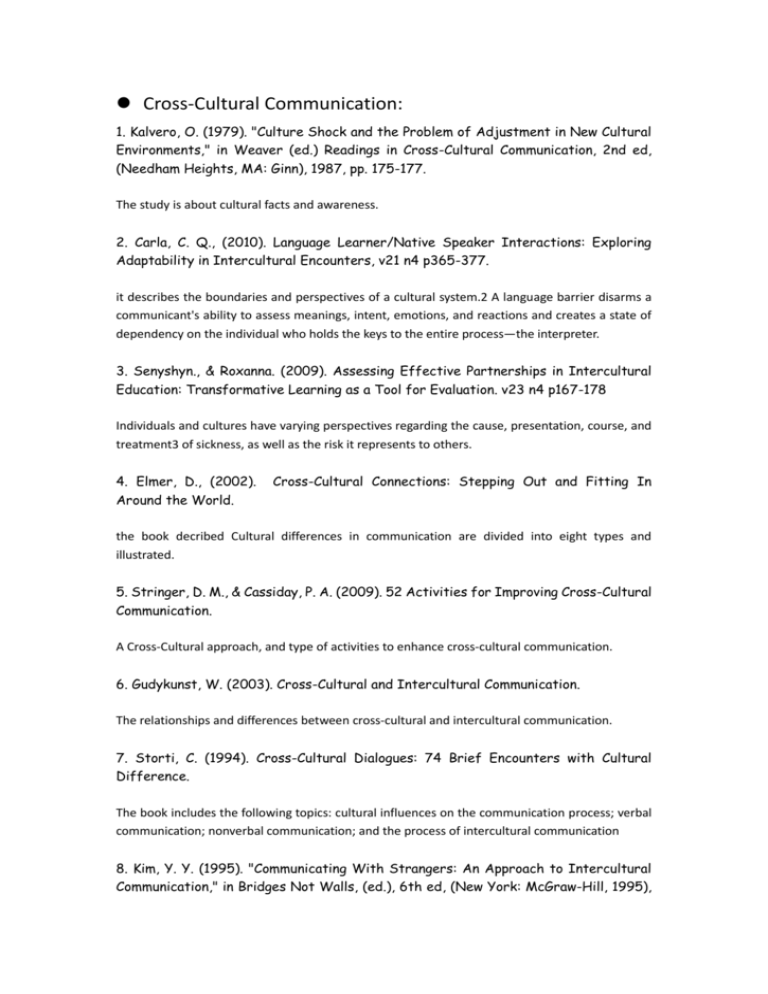
Cross-Cultural Communication: 1. Kalvero, O. (1979). "Culture Shock and the Problem of Adjustment in New Cultural Environments," in Weaver (ed.) Readings in Cross-Cultural Communication, 2nd ed, (Needham Heights, MA: Ginn), 1987, pp. 175-177. The study is about cultural facts and awareness. 2. Carla, C. Q., (2010). Language Learner/Native Speaker Interactions: Exploring Adaptability in Intercultural Encounters, v21 n4 p365-377. it describes the boundaries and perspectives of a cultural system.2 A language barrier disarms a communicant's ability to assess meanings, intent, emotions, and reactions and creates a state of dependency on the individual who holds the keys to the entire process—the interpreter. 3. Senyshyn., & Roxanna. (2009). Assessing Effective Partnerships in Intercultural Education: Transformative Learning as a Tool for Evaluation. v23 n4 p167-178 Individuals and cultures have varying perspectives regarding the cause, presentation, course, and treatment3 of sickness, as well as the risk it represents to others. 4. Elmer, D., (2002). Around the World. Cross-Cultural Connections: Stepping Out and Fitting In the book decribed Cultural differences in communication are divided into eight types and illustrated. 5. Stringer, D. M., & Cassiday, P. A. (2009). 52 Activities for Improving Cross-Cultural Communication. A Cross-Cultural approach, and type of activities to enhance cross-cultural communication. 6. Gudykunst, W. (2003). Cross-Cultural and Intercultural Communication. The relationships and differences between cross-cultural and intercultural communication. 7. Storti, C. (1994). Cross-Cultural Dialogues: 74 Brief Encounters with Cultural Difference. The book includes the following topics: cultural influences on the communication process; verbal communication; nonverbal communication; and the process of intercultural communication 8. Kim, Y. Y. (1995). "Communicating With Strangers: An Approach to Intercultural Communication," in Bridges Not Walls, (ed.), 6th ed, (New York: McGraw-Hill, 1995), pp. 429-442. Communication is sometimes more challenging with those who are different from us. To communicate successfully, we may need to be willing to accept the discomfort of unfamiliarity and uncertainty. 9. Cross Culture Communication. (n.d.). Retrieved from http://www.mindtools.com/CommSkll/Cross-Cultural-communication.htm Communication skills; cross-cultural communication; culture; stereotyping; interpreters 10. Pogrebin, L. C. (1995). "The Same and Different: Crossing Boundaries of Color, Culture, Sexual Preference Disability and Age," in Bridges Not Walls, (ed.), John Stewart, 6th ed, (New York: McGraw-Hill, 1995), pp. 445-459. Discusses cross-cultural communication as a process of becoming aware of another culture's habits, actions and reasons behind behaviours. Listening and Speaking: 1. Frazier, L. (2008). North Star: Listening and Speaking, Level 2, 3rd ed. ESL book, has great activities for English second language learner. 2. Grammar/Listening Project. (n.d.). Retrieved from http://www.esl-lab.com/ (highly recommended) The website is highly recommended by Memorial University of Newfoundland--ESL program. 3. Ten times faster for http://www.listeningexpress.com/ learning English. (n.d.). Retrieved from Tips for being a good listener. Also have different real listening practices for English second language learner. 4. Vangelisti, A., & Knapp, M., & Daly, J. (1990). "Conversational narcissism". Communication Monographs (57): 251–274. the limited research is supplemented herewith the insights of experts and educators with long and varied experience in the teaching of language skills. 5. The free encyclopedia. (n.d.). Retrieved from http://en.wikipedia.org/wiki/English_as_a_foreign_or_second_language 6. Solorzano, H. S. ( 2008). Northstar 3 Listening and Speaking, 3rd ed, pp. 63-79. This study examined strategies for English second language learners. ESL textbook. 7. Jeon, B. M., & Pederson, M. (2009). Dynamic Listening & Speaking. Provide evidence that how English second language learners be influenced by one's native language, consistent with linguistic relativity theory. 8. Cambridge First Certificate Listening and Speaking. (2000). pp. 12-40. "Cambridge First Certificate Listening and Speaking is designed to bridge the gap between creative skills training and systematic preparation for Papers 4 and 5 of the Cambridge First Certificate examination". 9. Hueber, M. (1999). Skill plus: Listening and Speaking - Advanced The textbook has a great variety of authentic listening types and vocabulary-building exercises to extend students' active vocabulary 10. Nation, I. S. P., & Newton, J. (2008). Teaching ESL/EFL Listening and Speaking. ESL & Applied Linguistics Professional Series. The text book has great layout such as content,Language-focused Learning through Dictation and Related Activities, and Learning through Task-focused Interaction, etc. Pronunciation: 1. Derwing, T. M., & Munro, M. J. (2010). Symposium--Accentuating the Positive: Directions in Pronunciation Research. Language Teaching, v43 n3. pp. 366-368. This book highlighted the major achievements of recent years in pronounciation and identified some of the important problems that remain. 2. Sara, K., & Pavel, T. (2010). Language Awareness and Second Language Pronunciation: A Classroom Study. Language Awareness, v19 n3. pp.171-185. This book examined the relationship between the quality of second language learners' language awareness and the quality of their L2 pronunciation. 3. Kazuya, S. (2011). Examining the Role of Explicit Phonetic Instruction in Native-Like and Comprehensible Pronunciation Development: An Instructed SLA Approach to L2 Phonology. Language Awareness, v20 n1. pp. 45-59. This paper reports on an instructed second language acquisition study that investigated the effects of explicit phonetic instruction on second language pronunciation by adopting two different outcome measurements. 4. Carolyn, S. (2010). Pronunciation Pegs. TESL Canada Journal, v27 n2. pp. 103-113. The appeal of pegs to students led the instructor to reflect on what makes adopting target pronunciation problematic, how pegs can be adapted to various learning styles, and how cultural differences can have an effect on the appreciation of pegs. 5. Huang, S. H. (2009). A Post-method Condition Pronunciation Teaching Approach in an EFL Classroom in Taiwan. Close and detailed observation taking place in an EFL classroom in Taiwan is described. 6. Chan., & Alice, Y. W. (2010). Advanced Cantonese ESL Learners' Production of English Speech Sounds: Problems and Strategies. System: An International Journal of Educational Technology and Applied Linguistics, v38 n2. pp. 316-328. This article discusses the production of English speech sounds by advanced Cantonese ESL learners in Hong Kong. 7. Talia, I. (2009). Integrating Form and Meaning in L2 Pronunciation Instruction. TESL Canada Journal, v27 n1. pp. 1-12. This book gathered then central challenges of ESL teaching is striking the right balance between form and meaning. 8. Ambra, Neri. (2008). The Effectiveness of Computer Assisted Pronunciation Training for Foreign Language Learning by Children. Computer Assisted Language Learning, v21 n5. pp. 393-408. This study investigates whether a computer assisted pronunciation training (CAPT) system can help young learners improve word-level pronunciation skills in English as a foreign language at a level comparable to that achieved through traditional teacher-led training. 9. Gillian, Lord. (2010). The Combined Effects of Immersion and Instruction on Second Language Pronunciation. Foreign Language Annals, v43 n3. pp. 488-503. The study investigates the acquisition of second language phonology with respect to two variables. 10. Miki, S. (2010). How Japanese Teachers of English Perceive Non-Native Assistant English Teachers. System: An International Journal of Educational Technology and Applied Linguistics, v38 n1. pp. 124-133. This book talked about whether Japanese teachers of English prefer assistant teachers with native-like pronunciation. Reading and Writing: 1. Berish, L., & Thibaudeau, S. (1998). Canadian Concepts, 5th ed. in its 5th edition, Reading, Writing, and Learning in ESL continues to capitalize on the strengths of previous editionsas it addresses the theory and practice of second language (L2) teaching in a reader-friendly manual. 2. Angelillo, J., & Ray, K. W. (2003, August 13). Writing About Reading: From Book Talk to Literary Essays, Grades 3-8. This book is for students who grow up speaking English. Can also be used in ESL class room for students who are in the lower to intermediate level. 3. Fletcher, R., & Portalupi, J. ( 2001, September). Writing Workshop: The Essential Guide From the authors of Craft Lessons. Results showed that the writing system and the reading system share many of the same orthographic. 4. Drost, H. (n.d.). Effective Article Writing-How to Write an Ariticle Part 2. Retrieved from http://www.isitebuild.com/article-writing-2.html Guide to effective English writing. 5. Nelson, D. (n.d.). Ten Tips for Effective Internet Article Writing. Retrieved from http://www.a1-optimization.com/article-writing-tips.htm Guide to effective English writing. 6. Econnect Communication. (2002). Top Tips for Writing Feature Articles. Guide to effective English writing. 7. Bailey, B., & Martin, G. (2010). ESL Models and Their Application: Electronic System Level Design and Verification in Practice. The book has some of the different types of essay. But it is a very complex resouce for either teachers or ESL students. 8. Oshima, A., & Hogue, A. (2007). The Longman Academic Writing Series. Introduction to Academic Writing, 3rd ed. The book is highly recommended by Okanagan College both ESL teachers and students. 9. Cohen, R. F., & Miller, J. L. (2003). Reason to Write: Stratigies for Success in Academic Writing. The book is highly recommended by Okanagan College both ESL teachers and students. 10. Kehe, D., & Kehe, P. D. (2003). Writing Strategies. A Student-Centered Approach. The book is highly recommended by Okanagan College both ESL teachers and students. Grammar: 1. Simon, B. (1998). Teachers' Pedagogical Systems and Grammar Teaching: A qualitative Study. Vol 32, (1).pp. 9-38. This interpretive study focuses on this issue by analysing the teaching of grammar in an L2 classroom from the perspective of the personal pedagogical systems—stores of beliefs, knowledge, theories, assumptions, and attitudes—that play a significant role in shaping teachers' instructional decisions. 2. Rod, E. (1997). SLA Research and Language Teaching. This book discusses how second language acquisition (SLA) research can illuminate language pedagogy, and suggests four main roles for the SLA researcher: developing relevant theories; conducting classroom research; making research accessible to teachers; and facilitating action research. 3. Nakata.,& Yoshiyuki. (2011). Teaching and Teacher Education: An International Journal of Research and Studies, v27 n5.pp. 900-910. many Japanese EFL high school teachers, while displaying different dimensions of autonomy in different ways, are not fully ready to promote autonomy in their learners. 4. David, S., & Beatrix, B. & Kyoung, S. H., & Ting, W. Y. (2011). Straight on through to Universal Grammar: Spatial Modifiers in Second Language. Acquisition Second Language Research, v27 n3. pp.289-311. This article provides evidence of a flow of information ostensibly in the opposite direction, from meaning to grammar, at the interface between lexical semantics and syntax. 5. Roy, L., & Susan, B. (2011). Content-Based Language Teaching: Convergent Concerns across Divergent Contexts. Language Teaching Research, v15 n3. pp279-288. This article serves as the introduction to this special issue of "Language Teaching Research" on content-based language teaching (CBLT). 6. Tracy, H. E. (2011). Influence of Second Language Cherokee Immersion on Children's Development of Past Tense in Their First Language, English. Language Learning, v61 n3. pp700-733. This study investigated second language on young children's and their first language, by comparing English past tense skills. 7. Fen, C. C., & Hua, K. C. (2011). A Corpus-Based Approach to Online Materials Development for Writing Research Articles. English for Specific Purposes, v30 n3. pp. 222-234. Numerous examples of specialized vocabulary, grammatical usage. 8. Barbara, S. (2011). Syntactic Creativity in Second Language English: "Wh"-Scope Marking in Japanese-English Interlanguage. Second Language Research, v27 n3. pp. 313-341. This article documents a fairly rare kind of interlanguage phenomenon. it is argued that "wh"-scope marking is a genuine phenomenon in Japanese-English interlanguages. 9. Gina, J. (2011). The Effectiveness of Teaching Traditional Grammar on Writing Composition at the High School Level. Grammar instruction is a challenging element of the English curriculum; both students and teachers struggle with the rules and dull nature of grammar. However, understanding grammar is important because students need to understand the language they speak in order to be effective communicators, and teachers provide grammar instruction with the express purpose of improving students' writing. 10. Dilin, L. (2011). Making Grammar Instruction More Empowering: An Exploratory Case Study of Corpus Use in the Learning/Teaching of Grammar. National Council of Teachers of English. Empowering grammar teaching, this study explores the use of corpora for problem-based learning/teaching of lexicogrammar in a college English grammar course. Vocabulary: 1. Tran, T. H. (2010). Gender and Language Use in the ESL Classroom. This literature review focuses on presenting an overview of research on language and gender. But also talk about discrepancies in major areas such as grammar, vocabulary, and pronunciation between women and men. 2. Jandrey, H. T. (2009). Student Attitudes toward Native and Non-Native Language Instructors. Foreign Language Annals, v42 n3. pp. 468-482. This study investigates students' attitudes toward native and nonnative speaking instructors of English, and their theching ability. 3. Mike, L. (2009). Technologies in Use for Second Language Learning. Modern Language Journal, v93 ns1. pp. 769-782. This article describes the technologies in use for second language learning, in relation to the major language areas and skills.Including grammar, vocabulary, reading, writing, pronunciation, listening, speaking, and culture. 4. Rossiter, M. J. (2009). Perceptions of L2 Fluency by Native and Non-Native Speakers of English. Canadian Modern Language Review, v65 n3. pp. 395-412. This article explores perceptions of the speaking fluency of 24 adult ESL learners, and recorded their impressions of the fluency of the stimuli. salient non-temporal impressions included pronunciation, grammar, and vocabulary. 5. Birch, B. M. (2007). English L2 Reading: Getting to the Bottom. 2nd ed. Lawrence Erlbaum Associates. This book examinated of how L1 features can influence English L2 reading at the "bottom" of the reading process. 6. Kazuko, A. ( 2003). Using Games To Teach English in Japanese Junior High School. This paper discuses how to integrate games into junior high school English classes in Japan. Games in the areas of vocabulary development, grammar, pronunciation, and a combination of the above. 7. Silliman, A. E. (2002-2003). Hands-On English: A Periodical for Teachers and Tutors of Adult English as a Second Language. Hands-On English, v12 n1. This book has readers' comments and questions; in-class map practice ideas; songs for English-as-a-Second-Language (ESL) learning; suggested films to show in class; conversation activities; dictation activities; crossword puzzles. 8. Sauve, V. L. (2002). Storyweavers: Holistic Education for ESL/EFL Learners. TESL Canada Journal, v20 n1. pp. 89-112. Shows how story can assume a central role in building community in an adult English-as-a-Second-Language classroom. 9. Hill, M. (2000). English Vocabulary: Tests and Tasks. This paper discusses the amount of vocabulary required by students learning in a second language to comprehend academic texts, explaining that a wide vocabulary is essential for reading comprehension and for speaking and writing clearly. 10. Scott, B., & Wachowicz, K. (1999). Software That Listens: It's Not a Question of Whether, It's Question of How. The book has activities for vocabulary development, conversational practice, and pronunciation.


